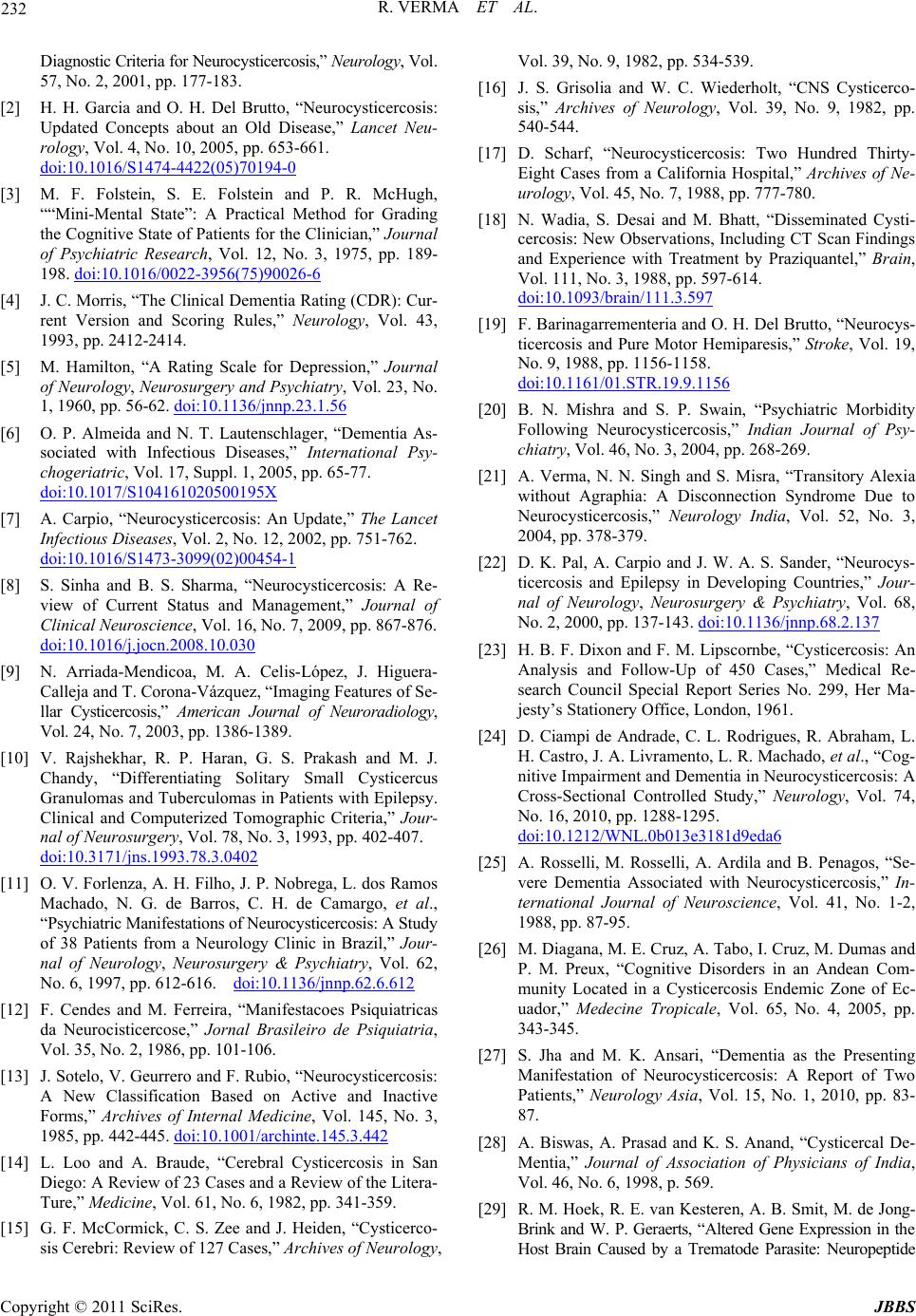
R. VERMA ET AL.
232
Di agnostic Criteria for Neurocy sticercosis,” Neurology, Vol .
57, No. 2, 2001, pp. 177-183.
[2] H. H. Garcia and O. H. Del Brutto, “Neurocysticercosis:
Updated Concepts about an Old Disease,” Lancet Neu-
rology, Vol. 4, No. 10, 2005, pp. 653-661.
doi:10.1016/S1474-4422(05)70194-0
[3] M. F. Folstein, S. E. Folstein and P. R. McHugh,
““Mini-Mental State”: A Practical Method for Grading
the Cognitive State of Patients for the Clinician,” Journal
of Psychiatric Research, Vol. 12, No. 3, 1975, pp. 189-
198. doi:10.1016/0022-3956(75)90026-6
[4] J. C. Morris, “The Clinical Dementia Rating (CDR): Cur-
rent Version and Scoring Rules,” Neurology, Vol. 43,
1993, pp. 2412-2414.
[5] M. Hamilton, “A Rating Scale for Depression,” Journal
of Neurology, Neurosurgery and Psychiatry, Vol. 23, No.
1, 1960, pp. 56-62. doi:10.1136/jnnp.23.1.56
[6] O. P. Almeida and N. T. Lautenschlager, “Dementia As-
sociated with Infectious Diseases,” International Psy-
chogeriatric, Vol. 17, Suppl. 1, 2005, pp. 65-77.
doi:10.1017/S104161020500195X
[7] A. Carpio, “Neurocysticercosis: An Update,” The Lancet
Infectious Diseases, Vol. 2, No. 12, 2002, pp. 751-762.
doi:10.1016/S1473-3099(02)00454-1
[8] S. Sinha and B. S. Sharma, “Neurocysticercosis: A Re-
view of Current Status and Management,” Journal of
Clinical Neuroscience, Vol. 16, No. 7, 2009, pp. 867-876.
doi:10.1016/j.jocn.2008.10.030
[9] N. Arriada-Mendicoa, M. A. Celis-López, J. Higuera-
Calleja and T. Corona-Vázquez, “Imaging Features of Se-
llar Cysticercosis,” American Journal of Neuroradiology,
Vol. 24, No. 7, 2003, pp. 1386-1389.
[10] V. Rajshekhar, R. P. Haran, G. S. Prakash and M. J.
Chandy, “Differentiating Solitary Small Cysticercus
Granulomas and Tuberculomas in Patients with Epilepsy.
Clinical and Computerized Tomographic Criteria,” Jour-
nal of Neurosurgery, Vol. 78, No. 3, 1993, pp. 402-407.
doi:10.3171/jns.1993.78.3.0402
[11] O. V. Forlenza, A. H. Filho, J. P. Nobrega, L. dos Ramos
Machado, N. G. de Barros, C. H. de Camargo, et al.,
“Psychiatric Manifestations of Neurocysticercosis: A Study
of 38 Patients from a Neurology Clinic in Brazil,” Jour-
nal of Neurology, Neurosurgery & Psychiatry, Vol. 62,
No. 6, 1997, pp. 612-616. doi:10.1136/jnnp.62.6.612
[12] F. Cendes and M. Ferreira, “Manifestacoes Psiquiatricas
da Neurocisticercose,” Jornal Brasileiro de Psiquiatria,
Vol. 35, No. 2, 1986, pp. 101-106.
[13] J. Sotelo, V. Geurrero and F. Rubio, “Neurocysticercosis:
A New Classification Based on Active and Inactive
Forms,” Archives of Internal Medicine, Vol. 145, No. 3,
1985, pp. 442-445. doi:10.1001/archinte.145.3.442
[14] L. Loo and A. Braude, “Cerebral Cysticercosis in San
Diego: A Review of 23 Cases and a Review of the Lite ra -
Ture,” Medicine, Vol. 61, No. 6, 1982, pp. 341-359.
[15] G. F. McCormick, C. S. Zee and J. Heiden, “Cysticerco-
sis Cerebri: Review of 127 Cases,” Archives of Neurology,
Vol. 39, No. 9, 1982, pp. 534-539.
[16] J. S. Grisolia and W. C. Wiederholt, “CNS Cysticerco-
sis,” Archives of Neurology, Vol. 39, No. 9, 1982, pp.
540-544.
[17] D. Scharf, “Neurocysticercosis: Two Hundred Thirty-
Eight Cases from a California Hospital,” Archives of Ne-
urology, Vol. 45, No. 7, 1988, pp. 777-780.
[18] N. Wadia, S. Desai and M. Bhatt, “Disseminated Cysti-
cercosis: New Observations, Including CT Scan Findings
and Experience with Treatment by Praziquantel,” Brain,
Vol. 111, No. 3, 1988, pp. 597-614.
doi:10.1093/brain/111.3.597
[19] F. Barinagarrementeria and O. H. Del Brutto, “Neurocys-
ticercosis and Pure Motor Hemiparesis,” Stroke, Vol. 19,
No. 9, 1988, pp. 1156-1158.
doi:10.1161/01.STR.19.9.1156
[20] B. N. Mishra and S. P. Swain, “Psychiatric Morbidity
Following Neurocysticercosis,” Indian Journal of Psy-
chiatry, Vol. 46, No. 3, 2004, pp. 268-269.
[21] A. Verma, N. N. Singh and S. Misra, “Transitory Alexia
without Agraphia: A Disconnection Syndrome Due to
Neurocysticercosis,” Neurology India, Vol. 52, No. 3,
2004, pp. 378-379.
[22] D. K. Pal, A. Carpio and J. W. A. S. Sander, “Neurocys-
ticercosis and Epilepsy in Developing Countries,” Jour-
nal of Neurology, Neurosurgery & Psychiatry, Vol. 68,
No. 2, 2000, pp. 137-143. doi:10.1136/jnnp.68.2.137
[23] H. B. F. Dixon and F. M. Lipscornbe, “Cysticercosis: An
Analysis and Follow-Up of 450 Cases,” Medical Re-
search Council Special Report Series No. 299, Her Ma-
jesty’s Stationery Office, London, 1961.
[24] D. Ciampi de Andrade, C. L. Rodrigues, R. Abraham, L.
H. Castro, J. A. Livramento, L. R. Machado, et al., “Cog-
nitive Impairment and Dementia in Neurocysticercosis: A
Cross-Sectional Controlled Study,” Neurology, Vol. 74,
No. 16, 2010, pp. 1288-1295.
doi:10.1212/WNL.0b013e3181d9eda6
[25] A. Rosselli, M. Rosselli, A. Ardila and B. Penagos, “Se-
vere Dementia Associated with Neurocysticercosis,” In-
ternational Journal of Neuroscience, Vol. 41, No. 1-2,
1988, pp. 87-95.
[26] M. Diagana, M. E. Cruz, A. Tabo, I. Cruz, M. Dumas and
P. M. Preux, “Cognitive Disorders in an Andean Com-
munity Located in a Cysticercosis Endemic Zone of Ec-
uador,” Medecine Tropicale, Vol. 65, No. 4, 2005, pp.
343-345.
[27] S. Jha and M. K. Ansari, “Dementia as the Presenting
Manifestation of Neurocysticercosis: A Report of Two
Patients,” Neurology Asia, Vol. 15, No. 1, 2010, pp. 83-
87.
[28] A. Biswas, A. Prasad and K. S. Anand, “Cysticercal De-
Mentia,” Journal of Association of Physicians of India,
Vol. 46, No. 6, 1998, p. 569.
[29] R. M. Ho ek , R. E. va n K es te re n, A . B . S mit , M . d e J ong-
Brink and W. P. Geraerts, “Altered Gene Expression in the
Host Brain Caused by a Trematode Parasite: Neuropeptide
Copyright © 2011 SciRes. JBBS